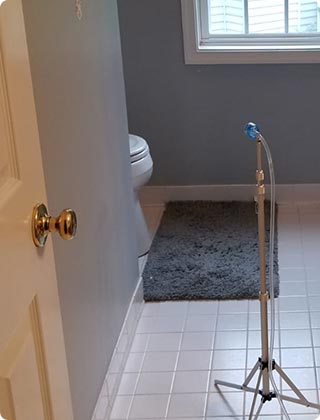MENU

Did a friend suggest that you get a mold inspection done? You might be wondering why it is essential to have one done and how the process goes. However, before we launch into the procedures, one thing you need to know is "what is mold?"
Once you understand what mold is and how dangerous it is to your health, you would know why a mold inspection is essential. Mold is a kind of fungus that thrives in moist places and reproduce in air-borne spores. There are over 400,000 types of mold.
While only a few dozen have proven to be toxic mold, mold exposure can not only lead to health problems, but it also damages your property. It is essential to check the growth of mold. The first step in preventing the growth of mold is to find it.
However, mold grows in hidden places,like behind the wall and under the carpet. So, you need a professional to find all hidden mold sources in your house.
Do you suspect the growth of mold in your house? You can call our professional experts to help you inspect for mold. You might be curious as to what inspectors do when they test for mold. We have given you the answer below.

Mold inspectors are coming to your house to test for mold, and you are wondering how they will do it. We will take you through the mold inspection procedure so that nothing will catch you by surprise. You can understand what a mold inspector would do right from the basic one to the more advanced testing methods explained below.
The first step that a mold inspector carries out after consulting with you is to inspect visually the possible hidden mold sources. During the consultation, experts would ask questions about your suspicion of where the mold might be found.
You might have noticed a particular moldy smell or seen mold growth in some areas. These areas will be the first locations inspected. The age and history of your building will also play a role in the inspection.
The experience that these professionals have makes it easier for them to spot mold. They could also use infrared imaging to find areas with moisture beneath surfaces that allow mold growth. This technology makes knowing where the mold is straightforward.
A mold inspection is aimed at identifying where mold is likely to be growing. If you need to know whether the mold is dangerous to your health, professionals carry out further testing or probing to see the kind of mold you have. We have explained these advanced procedures below.
Surface sampling or testing can be the next step after visual inspection. There are different methods used in obtaining the data for this testing.
Mold inspectors could use bulk sampling where they take part of the sampled area to the labs. A swab, something like cotton wool, is rubbed across certain surfaces for testing.
Professionals also make use of tape to remove mold on a surface, then test it. Surface probes help narrow in on the mold, and testing helps to know the type. Your mold inspector might also carry out air testing, which is explained below.
Air sampling can be done in several ways. It involves sampling the air in your house for the presence of mold. A spore trap or mold sampling could be used by the inspector to check for mold. These methods involved capturing mold spores in the air.
After mold spores have been found, the inspector would take the sample to the lab for testing. A professional mold inspector would take time to explain the results of this testing to you. You would also get to know the sources of the mold so you can fix them.
Mold inspection is incomplete if it does not lead to mold remediation. If mold inspectors find mold in your home, the next step after air and surface testing is remediation. Remediation begins by finding the cause of the problem and fixing it.
Experts who perform mold testing also can write up a complete plan for the future mold remediation, called the mold remediation protocol. The mold remediation expert will make use of the reports of the testing as well as the mold remediation protocol to fix the mold problem. This enables the mold remediator to get right to work, without having to duplicate the work already done in the mold inspection.
The cost of a mold inspection depends on the apartment's or your building size and the inspection service you use. However, a standard mold inspection usually costs $149 to $395 for an average house. If you want more sampling and testing of your home, you would also have to pay more.
One school of thought argues that mold inspection is not worth the time and money spent. In cases where your mold is noticeable, and you know it is the toxic black mold or don't care what type of mold is growing, a mold inspection is not worth your time. Instead, it would be best if you skipped to the remediation.
However, if you can smell the mold but not see it or just moved into a new house, a mold inspection is really necessary, and worth your time and money. You should also carry one out if:
One of the biggest mistakes you could make is to try to carry out mold inspection yourself. Even the best of kits will not tell you how dangerous a particular mold is.
However, professionals have the experience and tools to inspect the mold and tell you how severe the problem is. You might be wondering where you can find these professionals. Do not look too far. We are right here for you.
O2 Mold Testing is the professional service you need. We are dedicated to helping our customers find the mold in their house using the most professional approach. We have modern equipment to aid our work with experienced, trained inspectors to use it effectively.
Our services include air sampling, moisture, and leak detection, surface sampling, and visual inspection. Are you worried that our services might not reach your area? To find out more, you can contact us at 888-202-1680!
Call us at 888-202-1680 today to have your house inspected!